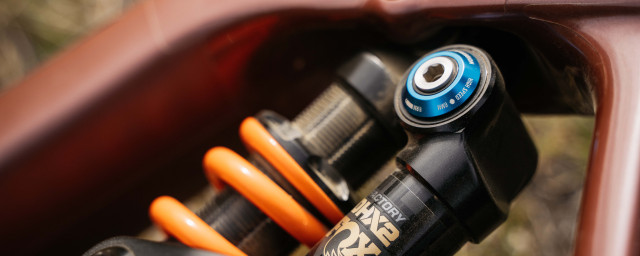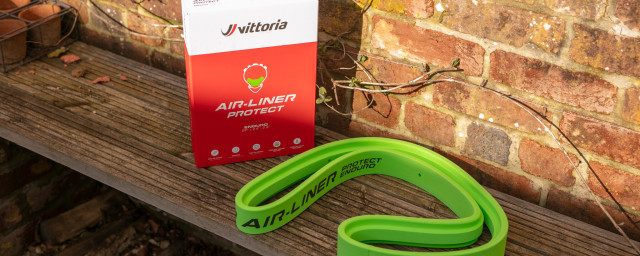The end of the road for the telescopic fork? Trust Performance create multi-link 'Message' fork

We've had our eye on the Instagram feed of Trust Performance ever since we were given the tip-off by someone close to the team. Now the big story has unfolded and we find out that three industry bods - including Dave Weagle of dw-link fame - have designed a brand new multi-link suspension fork for mountain bikes called the 'Message'.
- First Ride: Motion E-18 anti-dive linkage suspension fork put through its paces
- Five ways to make your bike faster for free
- Best mountain bikes for under £3,000 - capable trail bikes that won't break the bank
Four years in the making and with the brain power of Dave Weagle, Jason Schiers (of Edge/ ENVE creation) and Hap Seliga (from the Competitive Cyclist store) behind it, the Message fork is an outlandish looking 130mm travel fork that they say "has more traction in corners, and predictable steering and a level of small bump compliance that’s usually reserved for elite athletes with world-class, suspension-sponsored race support."
The fork itself is a 'trailing multi-link' design which has two air springs inside the carbon legs and a twin-tube, thru-shaft damper. The linkage design means the fork isn't forced to travel in line with the steering access as it would with a conventional telescopic fork - instead of just moving up and down, you can also adjust the axle path backwards and forwards too, much like your rear suspension can.
This allows for greater fine-tuning of how the fork responds through the travel, including allowing you to adjust offset and thus trail as the fork compresses, both of which are critical characteristics when it comes to a bike's stability.
Using a linkage design also overcomes some other issues inherent in a telescopic fork, namely that as the legs of the fork bend, it creates bushing bind which increases friction - and if you increase the diameter of the legs in order to stiffen it up and reduce bushing bind, the larger seals will, in turn, generate more static friction and resistance to movement - all of which reduce sensitivity.
Of course, there's a reason why telescopic forks are the dominant design in both the mountain bike and motorbike world. They're relatively simple and therefore cheap to produce, with lots of space to package in springs and dampers. The design also means they're relatively lightweight and the lack of moving parts relative to a linkage fork means there's less stuff to wear out and it's going to be less expensive when you do need a service.
There's quite a lot of technical jargon on the Trust Performance site - it almost seems designed to baffle in places - but it boils down to some pretty basic bike handling theory. The head angle, wheel size and fork offset of your bike all interact to produce something called trail, which describes the self-centring effect of how much the wheel wants to stop turning and move back to continuing in a straight line.
A trolley wheel is a good example of this - think of the wheel as being dragged around behind the steering axis that it can pivot around. A bicycle front end is just this put on at an angle.
A greater trail figure can be equated with greater stability, which is why slacker head angles and shorter offset forks (both of which increase trail) have become an increasingly common sight. Due to the fixed nature of a telescopic fork, as it compresses, the head angle becomes steeper, which means less trail and less stability.
The Trust Performance fork is designed to decrease the fork offset as it compresses in order to keep the trail the same, maintaining that stability is maintained despite the steepening head angle. It's also possible to design in a force that counteracts brake dive, though their site is pretty woolly on whether they've done so.
Using a linkage allows tweaking of how the leverage rate and thus shock curve alter beyond simple air spring volume adjustment, with Trust saying: "The fork has an easy actuation feel early in the stroke and progressive ramp through the mid-stroke. The result: ground-hugging traction, increased confidence when pushing through berms and more bottom-out resistance at the end of the travel to handle large impacts and botched landings."
The theory is an interesting one but similar products also exist in varying forms; our Jon rode Motion's E-18 linkage fork earlier this year but others such as the fork on the Whyte PRST-1 aimed to offer consistent trail, a concept hanging around nearly 18 years ago. There have also been many, many iterations of the linkage fork in the motorcycling world, with BMW's Telelever being arguably the most successful.
At a claimed 1,980g the fork weighs as much as a 170mm Rockshox Lyrik or a Fox 36, despite having just 130mm of travel. While Trust says that they have 2,500 forks ready to ship, you'd best have deep pockets if you intend on being an early adopter as at $2,700 these aren't a cheap experiment.
The fork will fit 27.5" and 29ers and they claim that despite only having a single travel option, one product is suitable for a wide range of length of travel bikes and differing axle to crown lengths. It's designed to work with 110-150mm travel bikes and apparently performs best on 29ers and 27.5+ bikes.
We're extremely keen to give them a go to see if they live up to the hype - as with many linkage designs in the past, much has been promised but seldom delivered. Hopefully, the team behind The Message might actually turn that around.
- Trailing multi-link front suspension
- 130mm contour travel
- 1980 grams
- Full carbon chassis, steerer tube and linkages
- Three-way mode adjust - Firm, Mid, Open
- Trust engineered twin-tube, thru-shaft damper
- Fits both 29/27.5"+ (110-150mm) and 27.5" (130-150mm) bikes
- Tire widths up to 29 x 2.6” (762 x 66mm) max or 27.5 x 2.8" (744 x 78mm) max
- Easy setup with air pressure equal to rider weight
- 535mm axle-to-crown
- Fits existing mountain bikes with tapered head tube
- Boost 15x110mm thru axle (or with torque caps)
- Direct mount 180mm rotor (203mm max)
- 250 hours between service intervals
See www.trustperformance.com for more info
















